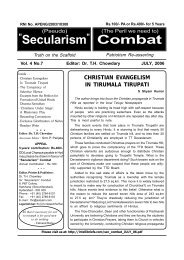Bharatiya Pragna - Dr. Th Chowdary
Bharatiya Pragna - Dr. Th Chowdary
Bharatiya Pragna - Dr. Th Chowdary
You also want an ePaper? Increase the reach of your titles
YUMPU automatically turns print PDFs into web optimized ePapers that Google loves.
Vishvavallabha was compiled by a<br />
scholar, Sri Chakrapani Mishra, around 1577<br />
AD. Chakrapani worked under the patronage<br />
of the towering personality of Maharana Pratap<br />
(1540–1597) of Mewar in Rajasthan. As is wellknown<br />
Maharana Pratap refused to surrender<br />
or be a vassal of the Mughal ruler, Akbar and<br />
protected his own honor as well as that of his<br />
people all through his life.<br />
<strong>Th</strong>e text contains a wealth of information.<br />
It describes methods to detect underground<br />
water, construction of water reservoirs, planting<br />
methods, plant disorders and treatments, and<br />
plantation in forts.<br />
Nuskha Dar Fanni-Falahat (<strong>Th</strong>e Art of Agriculture)<br />
(c. 1650)<br />
<strong>Th</strong>is text in Persian was copied from a<br />
compendium, Ganj-e-Badawar, compiled<br />
around 1650 AD by the Mughal prince Dara<br />
Shikoh, son of Shah Jahan, who built the famous<br />
Taj Mahal.<br />
<strong>Th</strong>e text briefly describes the “art” of<br />
growing about 100 economic plant species.<br />
<strong>Th</strong>ese include trees (fresh fruit, dry fruit, avenue,<br />
and timber), shrubs of ornamental significance,<br />
71<br />
vegetables, cereals, legumes, oilseeds, and aromatics.<br />
Species are grouped on the basis of similarities<br />
and the general sequence followed is: fresh<br />
fruit trees, dry fruit trees, berry-producing plants,<br />
avenue and timber trees, flowering shrubs, plantation<br />
crops, spices, aromatics, cereals, legumes,<br />
fiber crops, and vegetables. However, the sequence<br />
has not been followed strictly.<br />
Manures mentioned are dung, salt, and<br />
nitre for soil application in case of palm trees,<br />
nitre and vine sap as foliar application in vines,<br />
eggs in soil and olive leaf-sap sprinkling on<br />
leaves in fig, dung in soil in olive, pig’s dung and<br />
human urine in soil in pomegranate, night soil,<br />
animal dung, and sheep’s blood in soil in guava<br />
[pear (?)], dry dung of pig in almonds, and<br />
cowdung in carrots.<br />
Nitre as a fertilizer was new to the Indian<br />
agriculture as no document before the<br />
present one mentioned use of nitre as a manure.<br />
<strong>Th</strong>is must be therefore one of the first inorganic<br />
fertilizers used in India. <strong>Th</strong>e recommendation to<br />
sprinkle nitre on vines must have been based on<br />
observing beneficial effects on growth of vines.<br />
A statement under baqla (Vicia faba L.)<br />
is noteworthy. It is mentioned that roots,<br />
branches, and leaves of baqla “have the qualities<br />
of manure and it increases the strength of<br />
the manure” and that is why it is grown as an<br />
intercrop. <strong>Th</strong>is is a very significant statement<br />
pointing to the beneficial effects of legumes,<br />
which we know so well today.<br />
<strong>Th</strong>e contents of “Nuskha Dar Fanni-<br />
Falahat” are almost totally different from the earlier,<br />
indigenously written texts. It is not difficult<br />
to understand the reason. Historically speaking,<br />
the conquerors almost always despise the con-<br />
November & December 2008 <strong>Bharatiya</strong> <strong>Pragna</strong>



